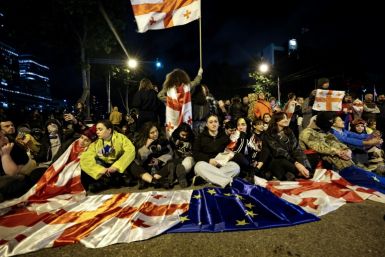Harnessed Technology in Search of Malaysian Airlines Flight 370: A Compilation of Deployed Satellites, Aircrafts, Ships and Other Tools From Participating Countries Worldwide
In over a two-week search of Malaysian Airlines Flight 370, technology has played a vital role in assisting to locate debris of the lost aircraft and will be essential in recovering wreckage from its resting place, deep below the southern Indian Ocean waters. Satellites, ships and planes search the area harnessing state-of-the-art sonar and radar imagery.
The search covers an area with 2.97 million square miles, almost as big as the U.S. providing leads but not proofs of where the lost Boeing 777-200 was. In the previous week, the search area shifted to the Indian Ocean's expanse more than 1,500 miles southwest of Australia, triggered by satellite images which showed "suspicious" objects in the water.
Here are the hardware involved in the difficult search among the planet's inhospitable corners, courtesy of CNN and CBS News:
I. Satellite
Gaofen-1 (China)
From the early stages of the search, China deployed satellite assets, including Gaofen-1, the optical satellite for earth observation which was credited to the latest sightings of "suspect images" floating in the southern Indian Ocean. The images were also obtained and analyzed by Australia from another commercial satellite.
EO-1 (U.S.)
NASA said it will deploy space-based assets to the Indian Ocean like the Earth-Observing-1 (EO-1) satellite and the International Space Station remote-controlled ISERV camera to acquire possible crash site images.
II. Aircraft
P-3 Orion (Australia, U.S., New Zealand and Japan)
Deployed as a submarine hunter in the 1960s and the cold war era, Lockheed's P-3 Orion is a modern air forces' mainstay, a number of variants of which join the MH370 search, including AP-3C Orion (Royal Australian Air force), P-3C (U.S. Navy), P-3K2 Orion (New Zealand Air Force) and P-3J Orion (Japanese Maritime Self Defense Force).
The P-3 Orion can remain in the air for up to 16 hours, perfect for search operations. It has sophisticated sensors on board, which can detect sound a thousand feet below water surface while it flies 200 feet above water.
P-8A Poseidon (U.S.)
Boeing's P-8A Poseidon from the U.S. Navy is arguably the world's most sophisticated anti-surface warfare and anti-submarine aircraft. The U.S. Navy said, it has a max speed of 490 knots, can fly up to 41,000 feet altitude and can cover over 1,200 nautical miles in four hours.
According to the U.S. Navy, for the MH370 search, P-8A will typically fly at 5,000 feet, dipping to 1,000 feet to have a closer look at objects in a search time of eight to nine hours. Its advance radar allows it to recognize and check small contacts on the water surface. Onboard camera system and many sensors can also be used in the search.
Ilyushin Il-76 (China)
The Chinese Air Force deployed two made-in-Russia Il-76 aircrafts. The medium-range, four-engine giant can be used as a military transporter or commercial freighter, carrying heavy payloads like vehicles and outsized cargoes via its ramp. It can breeze at a speed of 458 knots and an altitude of 39,370 feet. The aircraft has an Aerial-Delivery System (ADS) for dropping its cargo and other equipment in flight, which can be harnessed if a crash site is found.
III. Surface Equipment and Ships
Xuelong or Snow Dragon (China)
A Chinese icebreaker is heading toward the search area to help spot debris. It comes from a search rescue activity of a Russian research vessel stuck in Antarctic ice early this year. The helicopter-carrying vessel is expected to arrive Tuesday.
HMS Echo (Britain)
HMS Echo is a ship for coastal survey designed to carry out survey works like support to amphibious and submarine operations through oceanographic and bathymetric collections, ocean analysis, sound profile and salinity, the Royal Navy said.
7th Fleet (U.S.)
The 7th Fleet of the U.S. Navy is a major search contributor from the get-go, providing technical know-how, aircrafts and ships. In addition to air operations, the fleet sent surface ships with sophisticated search capabilities. According to Commander William J. Marks, spokesmann of the 7th Fleet, in case a debris is located, the fleet will move a "black box" locator to the site to provide significant advantage in searching for the missing airline's flight data recorder.
TPL-25 Towed Pinger Locator System (U.S.)
Marks said the TPL-25 Towed Pinger Locator System can locate black boxes to a depth of 20,000 feet max anywhere in the world. It is towed behind a vessel at slow speeds, at 1 to 5 knots depending on the depths. It carries a listening device to detect pingers that automatically transmit acoustic pulse.
IV. Automated Underwater Vehicle (AUV)
If the pinger could no longer function and the wreckage site is still not found, the search team can use AUV to map the ocean floor. It would be running a search through the ocean and a painstaking process at that - like mowing a lawn, up and back, collecting data for 20 hours, as shared by Paul Nelson, Phoenix International project manager, to CBS This Morning.
V. Remote Operated Vehicle (ROV)
When the search team will find the exact site of the wreckage, an ROV can be used to recover recorders and other pieces of the plane. Robert Paddock, an ROV technician and Great Lakes WATER Institute, told CBS News via an email, the ROV is the sole way to recover items from the bottom of the ocean. ROVs are used for deep water explorations and functions like assembly of pipes, electronics and fittings and even basic construction. It is especially useful where depth exceeds safe diving limits.






